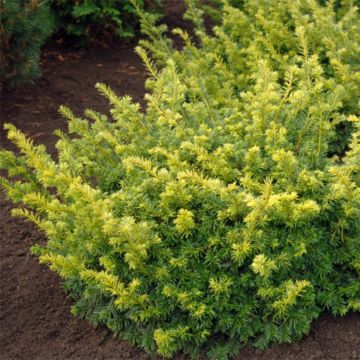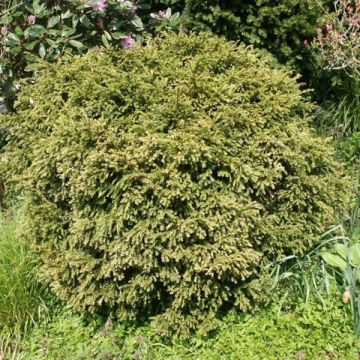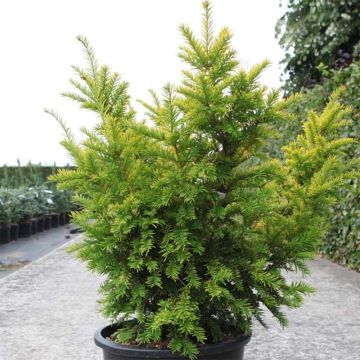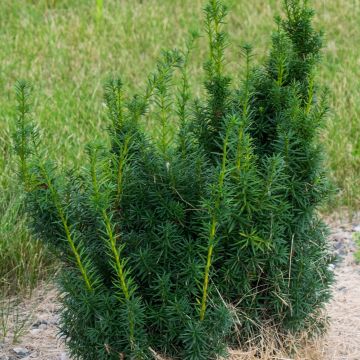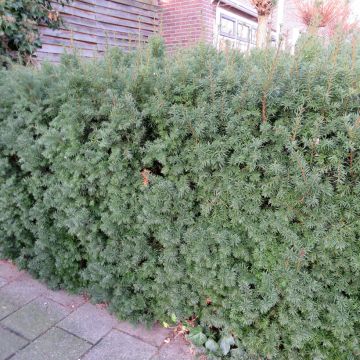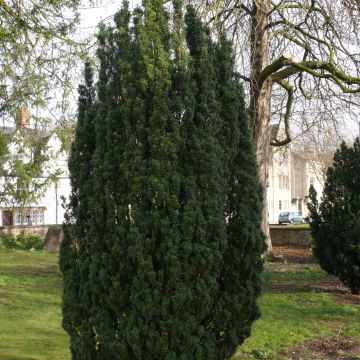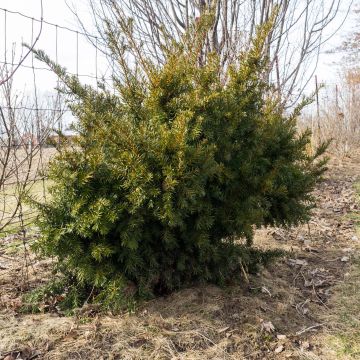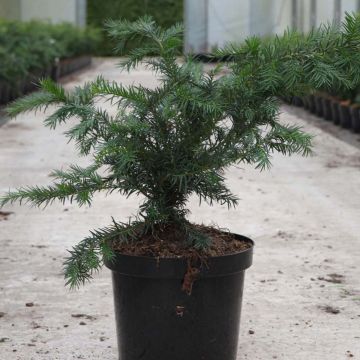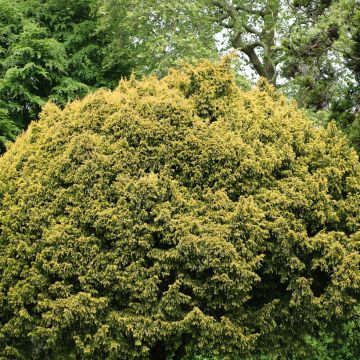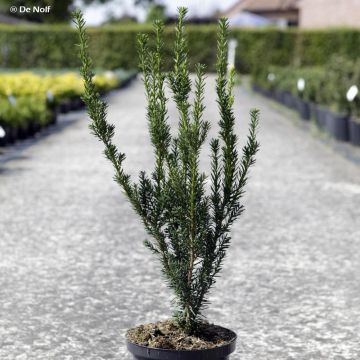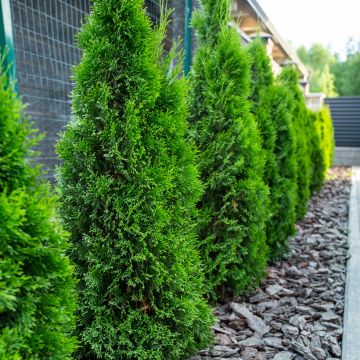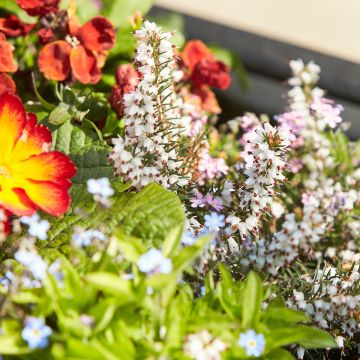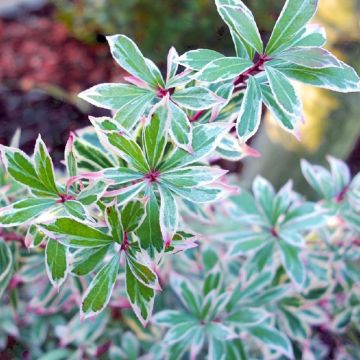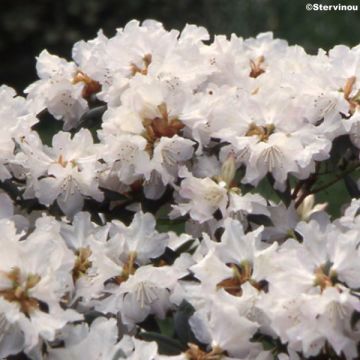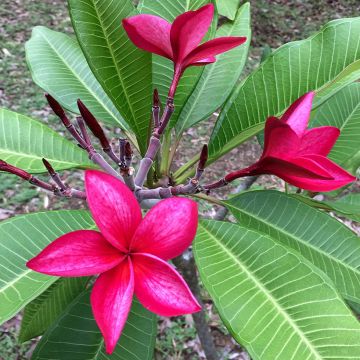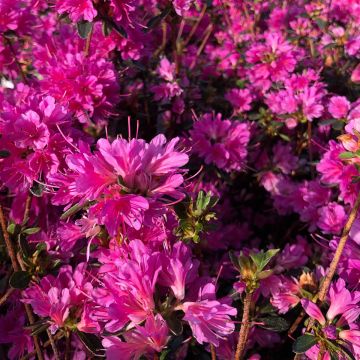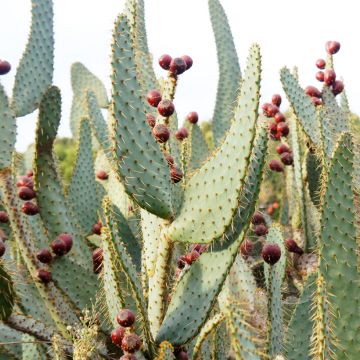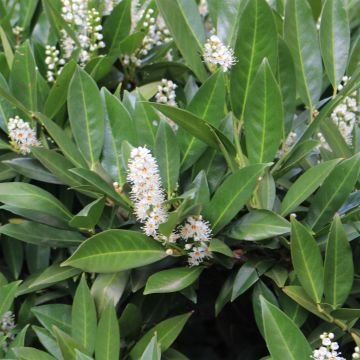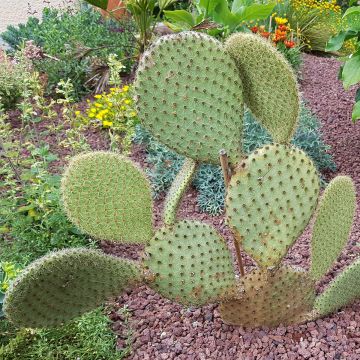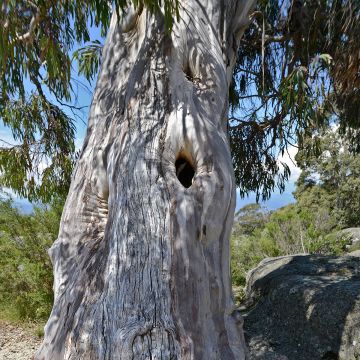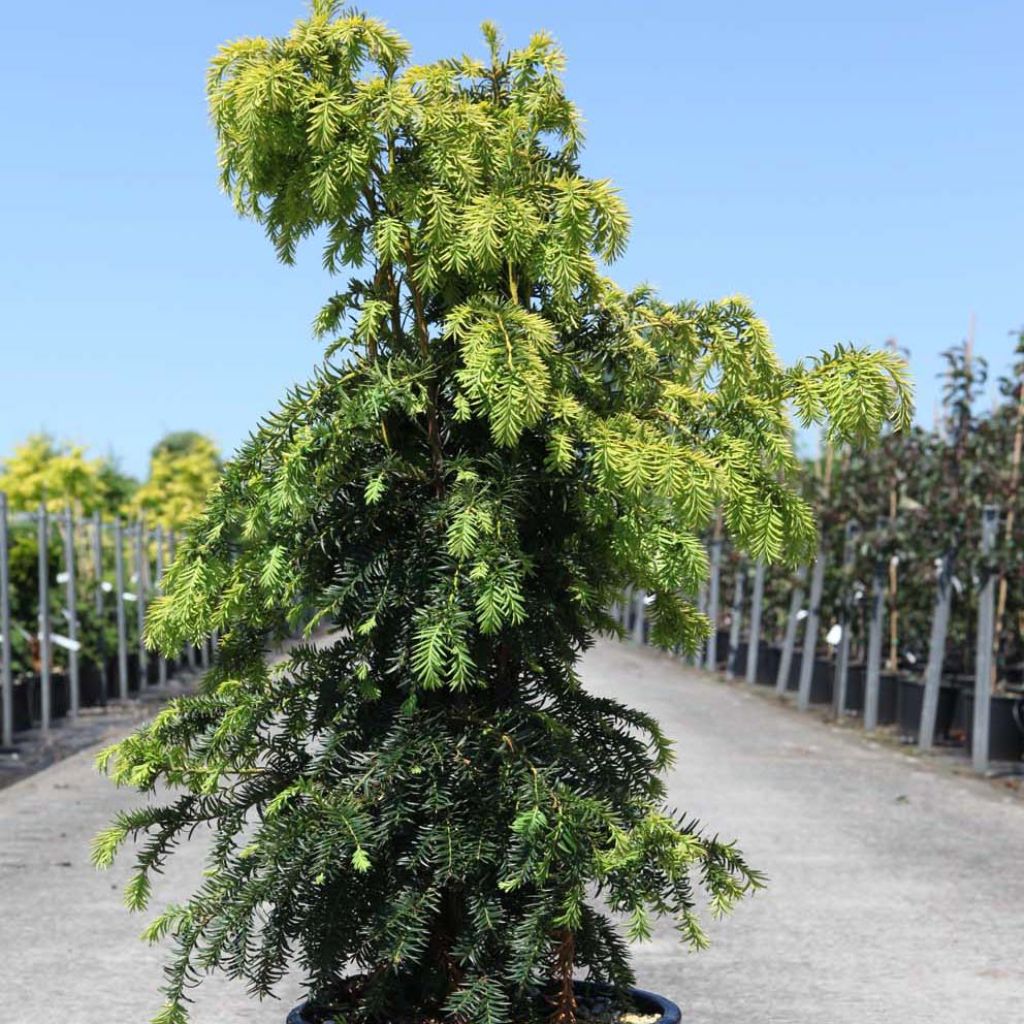

Taxus baccata Dovastonii Aurea - Yew
Taxus baccata Dovastonii Aurea - Yew
Taxus baccata Dovastonii Aurea
Yew, Common Yew, English Yew, European Yew
This plant carries a 24 months recovery warranty
More information
We guarantee the quality of our plants for a full growing cycle, and will replace at our expense any plant that fails to recover under normal climatic and planting conditions.
From €5.90 for pickup delivery and €6.90 for home delivery
Express home delivery from €8.90.
Does this plant fit my garden?
Set up your Plantfit profile →
Description
Taxus baccata 'Dovastonii Aurea' brings a touch of whimsy to the kingdom of the common yew, sometimes considered a bit austere. Adorned with beautiful golden foliage, this luminous conifer slowly forms a beautiful specimen as wide as it is tall with gracefully drooping branches that are adorned, on the female plants, with a lovely red fruiting in bright red arils. With moderate growth more suited to medium-sized gardens, attractive all year round, almost maintenance-free, hardy, adaptable to different soils, exposures, and climates, this shrub definitely has many advantages.
Very present in the oldest gardens and parks in Europe, Taxus baccata sometimes watch over us for hundreds of years. Their longevity is indeed remarkable and can reach several centuries. The species, which has become rare in the wild, is native to Europe, Asia Minor, and North Africa. In France, it is still present in the plains of Brittany, Normandy, and the Vosges, in low and medium mountains in the south and in Corsica. Some stands also survive in the limestone massifs of Provence, on the northern slopes of Sainte Baume and Sainte Victoire near Aix-en-Provence. Some specimens growing in the Verdon Gorge are said to be over a thousand years old. You can also admire impressive specimens in old gardens or cemeteries, near churches for symbolic reasons (considered as the link between heaven and earth), but also to prevent herds from consuming them. The needles, bark, and fruits are indeed toxic to humans and animals, except for birds that consume the berries and discard the seeds. The common yew is a conifer of the Taxodium family, just like Cryptomerias and Metasequoias.
The 'Dovastonii Aurea' cultivar distinguishes itself with its small size, wide, spreading, and weeping habit, and golden foliage. Slow-growing, it will not exceed 5m (16ft 5in) in all directions. It is characterized by an open and airy crown. Its long flexible branches and trunk are covered with reddish-brown bark that flakes off. Its branchlets are adorned with flattened, yellow to yellow-green needles that are shiny and have two white bands on the undersides, with a pointed tip but very soft to the touch. It provides a presence throughout the seasons and often forms the backbone of the garden. It is a dioecious tree: individuals bear male or female flowers. Thus, the red berries appear after a discreet flowering only on the female plants. It is also a honey tree.
Taxus baccata 'Dovastonii Aurea' will find its place in all gardens, even small ones, from the North to the South of our country, and will adapt to all styles: strict, whimsical, classic, romantic, contemporary, mineral, or poetic. And this is even more true since this yew is not only very hardy but also accepts all types of soil: ordinary, slightly acidic or alkaline, moist or dry. It can be a beautiful standalone specimen or be accompanied by equally frugal creeping shrubs (Cotoneaster, Chamaecyparis, and dwarf junipers, Coprosma..). Pruning is not necessary or is limited to one intervention per year, and it will successfully regenerate after a more severe cut by penetrating the old wood. Indifferent to exposure, it can even be planted in the shade. If you want to keep it near entrances, it also thrives in containers.
Report an error about the product description
Taxus baccata Dovastonii Aurea - Yew in pictures
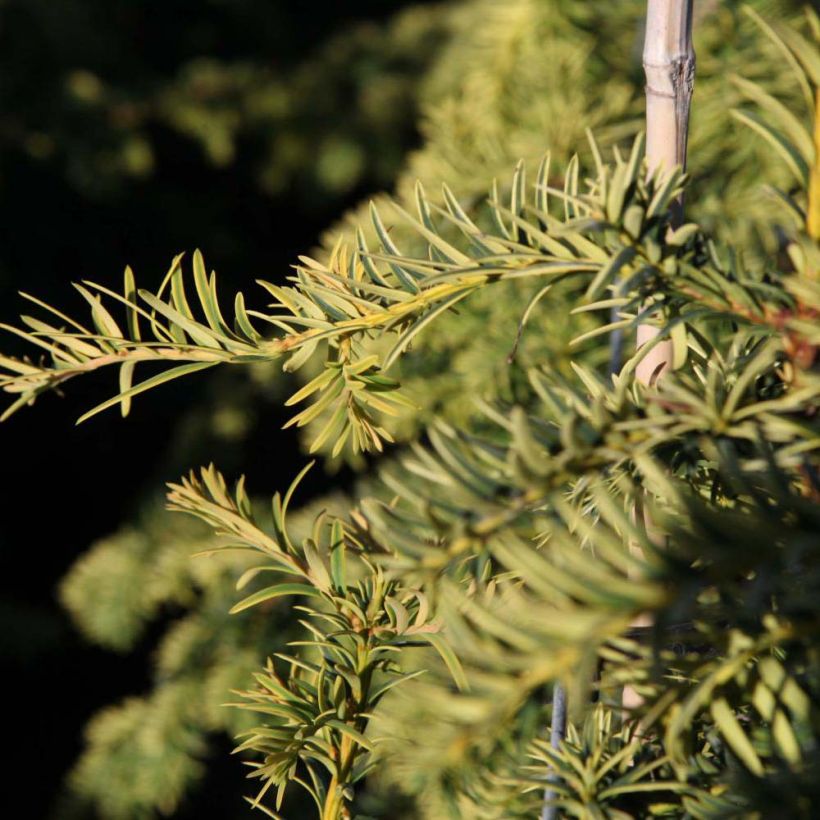

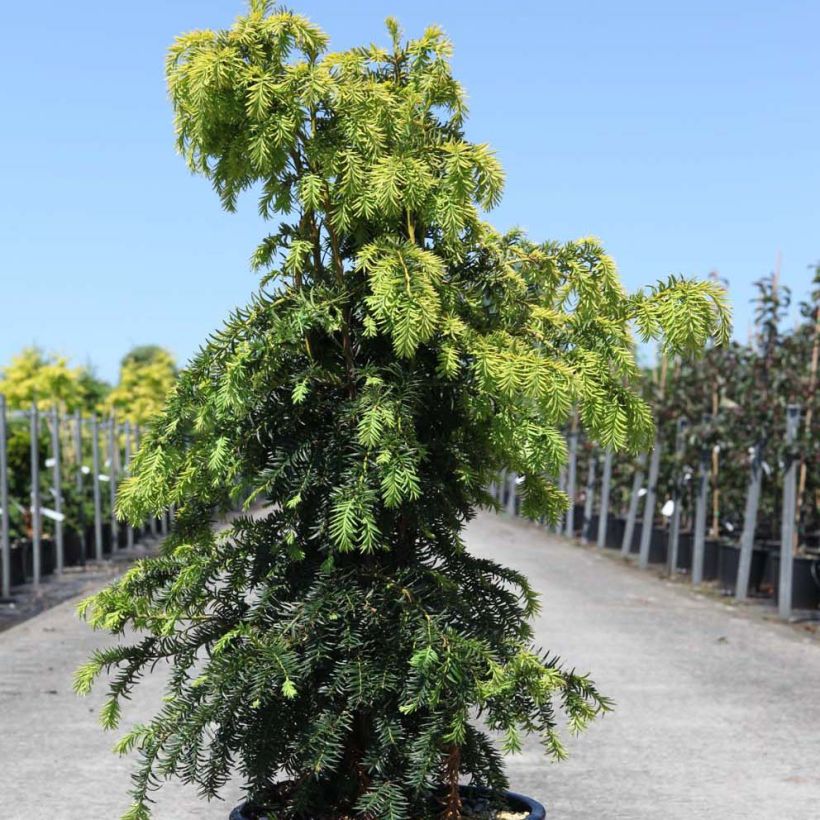

Plant habit
Flowering
Foliage
Safety measures
Botanical data
Taxus
baccata
Dovastonii Aurea
Taxaceae
Yew, Common Yew, English Yew, European Yew
Cultivar or hybrid
ingestion
Cette plante est toxique si elle est ingérée volontairement ou involontairement.
Ne la plantez pas là où de jeunes enfants peuvent évoluer, et lavez-vous les mains après l'avoir manipulée.
Pensez à conserver l'étiquette de la plante, à la photographier ou à noter son nom, afin de faciliter le travail des professionnels de santé.
Davantage d'informations sur https://plantes-risque.info
Other Taxus - Yew
Planting and care
The common yew is really undemanding, and that is undoubtedly one of its finest qualities. It thrives in full sun or partial shade, even in shade in hot climates, in well-prepared ordinary soil at planting, slightly chalky or acidic, moist to dry in summer. It easily adapts to all our climates and all our soils. It can be pruned twice a year, in spring and autumn (the latter allowing for readjustment of the former) in April and August (depending on your climate).
Planting period
Intended location
Care
This item has not been reviewed yet - be the first to leave a review about it.
Evergreen shrubs
Haven't found what you were looking for?
Hardiness is the lowest winter temperature a plant can endure without suffering serious damage or even dying. However, hardiness is affected by location (a sheltered area, such as a patio), protection (winter cover) and soil type (hardiness is improved by well-drained soil).

Photo Sharing Terms & Conditions
In order to encourage gardeners to interact and share their experiences, Promesse de fleurs offers various media enabling content to be uploaded onto its Site - in particular via the ‘Photo sharing’ module.
The User agrees to refrain from:
- Posting any content that is illegal, prejudicial, insulting, racist, inciteful to hatred, revisionist, contrary to public decency, that infringes on privacy or on the privacy rights of third parties, in particular the publicity rights of persons and goods, intellectual property rights, or the right to privacy.
- Submitting content on behalf of a third party;
- Impersonate the identity of a third party and/or publish any personal information about a third party;
In general, the User undertakes to refrain from any unethical behaviour.
All Content (in particular text, comments, files, images, photos, videos, creative works, etc.), which may be subject to property or intellectual property rights, image or other private rights, shall remain the property of the User, subject to the limited rights granted by the terms of the licence granted by Promesse de fleurs as stated below. Users are at liberty to publish or not to publish such Content on the Site, notably via the ‘Photo Sharing’ facility, and accept that this Content shall be made public and freely accessible, notably on the Internet.
Users further acknowledge, undertake to have ,and guarantee that they hold all necessary rights and permissions to publish such material on the Site, in particular with regard to the legislation in force pertaining to any privacy, property, intellectual property, image, or contractual rights, or rights of any other nature. By publishing such Content on the Site, Users acknowledge accepting full liability as publishers of the Content within the meaning of the law, and grant Promesse de fleurs, free of charge, an inclusive, worldwide licence for the said Content for the entire duration of its publication, including all reproduction, representation, up/downloading, displaying, performing, transmission, and storage rights.
Users also grant permission for their name to be linked to the Content and accept that this link may not always be made available.
By engaging in posting material, Users consent to their Content becoming automatically accessible on the Internet, in particular on other sites and/or blogs and/or web pages of the Promesse de fleurs site, including in particular social pages and the Promesse de fleurs catalogue.
Users may secure the removal of entrusted content free of charge by issuing a simple request via our contact form.
The flowering period indicated on our website applies to countries and regions located in USDA zone 8 (France, the United Kingdom, Ireland, the Netherlands, etc.)
It will vary according to where you live:
- In zones 9 to 10 (Italy, Spain, Greece, etc.), flowering will occur about 2 to 4 weeks earlier.
- In zones 6 to 7 (Germany, Poland, Slovenia, and lower mountainous regions), flowering will be delayed by 2 to 3 weeks.
- In zone 5 (Central Europe, Scandinavia), blooming will be delayed by 3 to 5 weeks.
In temperate climates, pruning of spring-flowering shrubs (forsythia, spireas, etc.) should be done just after flowering.
Pruning of summer-flowering shrubs (Indian Lilac, Perovskia, etc.) can be done in winter or spring.
In cold regions as well as with frost-sensitive plants, avoid pruning too early when severe frosts may still occur.
The planting period indicated on our website applies to countries and regions located in USDA zone 8 (France, United Kingdom, Ireland, Netherlands).
It will vary according to where you live:
- In Mediterranean zones (Marseille, Madrid, Milan, etc.), autumn and winter are the best planting periods.
- In continental zones (Strasbourg, Munich, Vienna, etc.), delay planting by 2 to 3 weeks in spring and bring it forward by 2 to 4 weeks in autumn.
- In mountainous regions (the Alps, Pyrenees, Carpathians, etc.), it is best to plant in late spring (May-June) or late summer (August-September).
The harvesting period indicated on our website applies to countries and regions in USDA zone 8 (France, England, Ireland, the Netherlands).
In colder areas (Scandinavia, Poland, Austria...) fruit and vegetable harvests are likely to be delayed by 3-4 weeks.
In warmer areas (Italy, Spain, Greece, etc.), harvesting will probably take place earlier, depending on weather conditions.
The sowing periods indicated on our website apply to countries and regions within USDA Zone 8 (France, UK, Ireland, Netherlands).
In colder areas (Scandinavia, Poland, Austria...), delay any outdoor sowing by 3-4 weeks, or sow under glass.
In warmer climes (Italy, Spain, Greece, etc.), bring outdoor sowing forward by a few weeks.

































